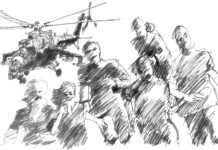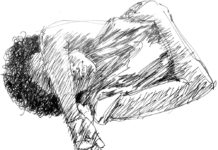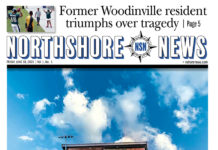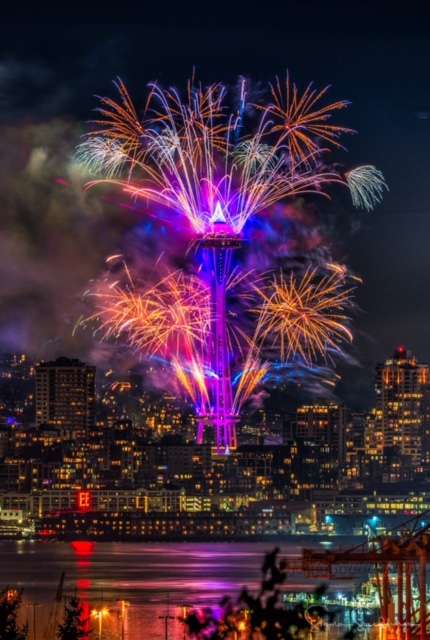
By Kim E. Kimmy
Many people know that the Space Needle was a concept that became a reality from a hastily drawn sketch on a cocktail napkin, but not everyone knows that Seattle’s famous icon’s spectacular New Year’s Eve fireworks show materialized from a ladies-lounge conversation.
In the ’80s and ’90s, when I was director of marketing at the Space Needle, the Seattle-King County Convention and Visitors Bureau staged breakfast events for its members called “Good Morning, Seattle.” These early morning meetings were held at various tourist attractions and were fun, informative and entertaining. One, held in early 1994, was on the top floor of the Columbia Tower. Not only is it Seattle’s tallest building, it’s famous for its elegant top-floor ladies room, featuring giant windows overlooking Lake Washington. They even had to put a brass sign outside the door requesting that ladies not escort gentlemen inside. Even if a lady has no need to powder her nose, it’s worth a visit.
On this particular morning, I was in this especially crowded powder room following the meeting when a woman approached me and asked if I were Kim Kimmy of the Space Needle. She introduced herself as Susan Hunt and asked if I realized that the renowned artist and pyrotechnics multimedia designer, Alberto Navarro, was right outside the door, as gentlemen often were. I’d never heard of him. She ebulliently offered that she’d be happy to introduce him to me as she had heard that I was interested in a more spectacular New Year’s Eve extravaganza at the Needle than the one our team began in December of 1985.
I had joined the Needle’s executive team in late November of 1984. The newly hired president and I both were stunned that there was nothing happening at the Needle to celebrate the Winter holidays. There were a few restaurant reservations, but nothing was booked on the 100-foot party level, nothing special was happening on the observation deck and there were no decorations on the outside of this iconic symbol of Seattle.
There wasn’t enough time that year to stage a New Year’s Eve production. The best we could do was string colorful lights from the Needle’s rooftop torch to form a Christmas tree, a tradition that has remained in the decades since. Our executive team went to work in 1985 to create a tradition for the residents and tourists of Seattle. Underneath the Needle’s outer ring, known as the halo, the Needle’s property department staff strung hundreds of multi-colored lights. Giant plywood numerals depicting 1986 also were attached to the halo’s underside and on the roof underneath the lights forming the Christmas tree. We also hired a brass quartet we had discovered performing on a Seattle street to play holiday songs at the Needle’s base.
A local radio station broadcast from the observation deck, featuring the talent now known nationally as Delilah. A local television station shot footage as—at 86 seconds to midnight—the Needle’s north elevator began its ascent. As the crowd began the countdown, the specially lit elevator climbed, reaching the top at the stroke of midnight. Simultaneously, the 1986 numerals were illuminated, as the colorful lights flashed sequentially around the halo and the brass band played, “Auld Lang Syne.” A cruise line donated a voyage to the first paying observation-deck guest of the year. It was the birth of a tradition of what we then called, “The Times Square of the West”—providing a New Year’s Eve gift to residents in the Pacific time zone.
The next few years, the production was similar with added lights, other popular bands, increasingly larger crowds, an emcee, more festivities inside, prize promotions and a sponsoring local television station broadcasting from the base, with other media often covering it as well.
But our big dream was a fireworks display.
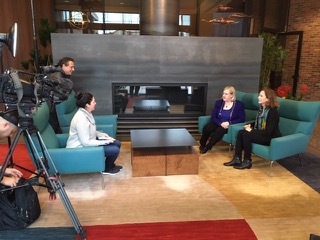
Navarro shared that vision. He and I were instantly simpatico. He had dreamed of painting the sky with fireworks over the Space Needle ever since he first flew over it when he moved to the Northwest from his native Spain in 1993.
We knew it would be difficult, with many obstacles to overcome, but we both refused to be discouraged by the naysayers who insisted it was impossible. The crucial first step was obtaining permission from the Seattle Fire Department. We were able to get a meeting with the fire chief, who previously had rejected even considering this impossible folly in a phone call made by the Needle’s president a few years earlier—although I didn’t know that. He agreed to respectfully listen to our idea, reiterating that Seattle had an ironclad rule that no fireworks were permitted on buildings. Furthermore, he pointed out that the Needle was on a busy street and New Year’s Eve is one of the most hectic nights of the year.
Navarro was prepared. His magic words were, “This is not fireworks. This is pyrotechnically enhanced special effects.” He presented the chief a 32-page report detailing combustion timing, distance and trajectories. The fire chief was impressed, saying he’d never seen such a complete report. It wasn’t enough, though. The main sticking point was being able to test it. But we had a plan to overcome that.
The first test was secretly staged on Lake Union in the late Fall, with Navarro working with his fireworks team, Pyrospectaculars. All 14 colors had to pass this first logistical hurdle, under the fire department’s supervision. Navarro and his Pyrospectaculars team had to custom-make all new pyrotechnics. The strict caveat was that they had to be completely clean, with no fallout.
While Navarro was handling that aspect, my next mission was to get permission from the Space Needle’s owner, the late Howard S. Wright, also a renowned visionary as one of Seattle’s foremost developers. Navarro and I were granted an audience in his high-rise domain, overlooking many of the Seattle buildings his construction company had erected. He trusted me from some previous high-profile projects and was impressed by Navarro’s vision and thoroughness. He gave us his blessing but made us promise we wouldn’t damage his most-famous building, and even agreed to handle the insurance logistics. As we left, he grinned, because he knew if we could truly pull this off, it would convert his beloved Space Needle into the largest and most spectacular venue for Pacific time zone celebrations.
The next obstacle was funding. The pre-New Year’s Eve test was spectacular, but minimal by fireworks standards. Nevertheless, all fireworks are expensive. The Space Needle Corporation covered the costs for the test, and I found a sponsor for the holiday show, assuming we cleared every hurdle. The fire department, our team and Navarro’s team had countless technical and logistical meetings. Together, we planned accompanying music, through computer generation, for what Navarro termed a “pyromusical.”
It’s not easy to keep activity atop Seattle’s main tourist attraction a secret. Navarro’s team did its part, the sponsor did its part and the Needle staff did its part. Thus far, we had kept our project confidential, but the next hurdle was the media. We needed their help, yet we didn’t want to expose our secret until the test.
I personally went to each local television station to meet with their program and news executives. Thankfully, I had long professional relationships with each, and we had mutual trust. I couldn’t even tell them the subject of our meeting, and warned each that if one word was even hinted about an upcoming event on December 28, it could change history. I urged each station to have its cameras pointed toward the Needle, south of Queen Anne Hill, between 11 and 11:30 that night. Of course, they wanted to know why, and I reiterated that I couldn’t reveal that, but promised—if all went well—it would be worth it. Their main concern was that whatever it was that was going to happen would happen before the close of the 11:30pm newscast.
We cut it close.
Mobile phones were a fairly new phenomenon, and they were critical for this project. By 11:15 pm, as I was anxiously pacing at a friend’s house on Queen Anne, my cell phone was ringing incessantly with communications among the Needle’s property department, the pyrotechnicians, the fire department, the police and me. I also was fielding media calls with news directors frustrated that nothing was happening. I had not even revealed to my friend why I needed to be in her house, by the way!
There were so many elements that could go wrong, and we had promised the fire department that if any one of them failed, they had the authority to scrub the operation. I felt like mission control at NASA awaiting a launch countdown. As the minutes ticked toward the crucial 11:30 broadcast conclusion, the team at the Needle continued to assure me all systems were go.
With the TV cameras and my eyes staring south, we finally were rewarded with a glorious “kaboom” and numerous colorful explosions of pyrotechnics from the Needle’s legs, core and crown. Seattle residents were surprised by what I like to think of as our then-greatest-ever local version of “shock and awe.” Navarro pointed out that, as an artist, he had the largest audience in the state of Washington, since no stadium can hold as many people as the number of Seattle’s residents and tourists who witnessed the show in person.
The fireworks test continued for a few minutes, with no injuries and no damage. Not only did the fire department give us the all clear, we now had footage to promote the real event set for December 31st. The Space Needle’s spectacular annual gift to Seattle began with that successful test, and a photo of the test was even published on the front page of the New York Times.
In the wee morning hours of January 1, 1995, our team met at a nearby hotel room, where two small boys were asleep. Not long before, I learned that Hunt was married to Navarro and that the little boys were theirs. A toast to a successful and extraordinary production was in order. Still giddy from the adrenaline, our team’s glasses were raised. I proposed that we honor the person who made an event happen that is now known worldwide.
All present assumed my toast would honor the creator and mastermind, Navarro, or the fire chief, or the sponsor, or the president, or owner of the Space Needle or its property manager. With a short preamble, I offered the toast to Susan Hunt—for pursuing me in the ladies room months before. Besides a unanimous “Awww” from all assembled, she also was rewarded with a big kiss and hug from her husband.
Every January 1, about 12:20am, I receive a text from Navarro thanking me for making it happen. He likes to say we gave the Northwest its biggest party. We made a great team.
Navarro, a resident of Bellevue, is now a software designer for fireworks and a multimedia designer for fireworks shows on six continents, through the couple’s Infinity Visions company. The Space Needle’s New Year’s Eve fireworks extravaganza remains his only Washington state gig.
Kim Kimmy resigned from the Space Needle in 1995 to launch Kim Kimmy Enterprises, providing marketing, public relations, research, writing and special-event services for a myriad of companies and organizations nationwide. She’s happily living in Anacortes, travels all over the world, writes and enjoys giving speaking engagements on such subjects as “Traveling on My Funnybone,” “My Interesting Brushes with the Famous” and emceeing trivia. When she’s not doing that, she’s singing with Sweet Adelines, and immersed in a plethora of philanthropic organizations.


